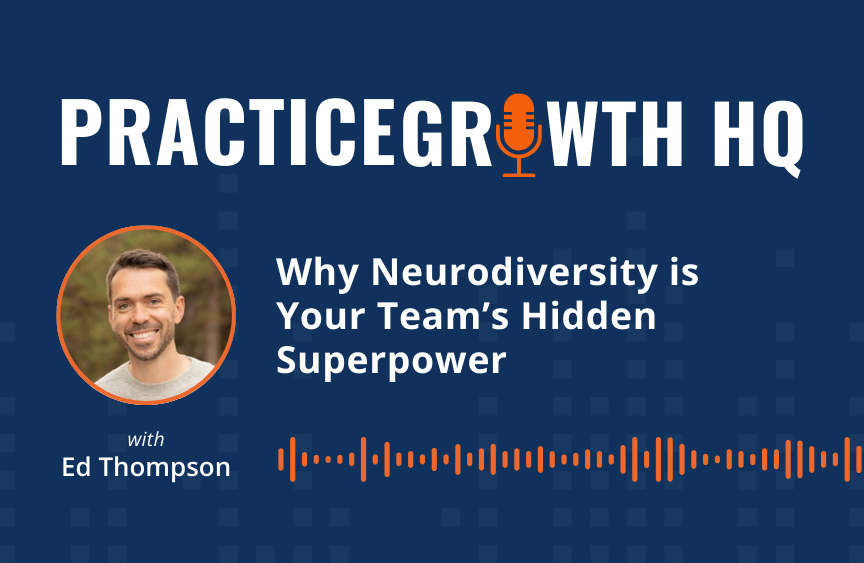In the latest episode of Practice Growth HQ, we delve into an incredibly important topic that too often flies under the radar: building stronger teams through understanding neurodiversity. Ed Thompson, author of the Amazon number one bestseller “A Hidden Force: Unlocking the Potential of Neurodiversity at Work,” breaks down the fundamentals of how recognizing and embracing different thinking styles can help us achieve better performance in our teams.
Appreciating Neurodiversity in Every Interaction
The first step is understanding that everyone thinks differently. What this means is that there’s no one-size-fits-all approach to communication, problem-solving, or even work environments. Every brain works differently, making each team inherently neurodiverse. Unfortunately, this fact is often buried under a medicalized perspective that sees certain neurotypes as outside the norm. By being proactive and appreciating these intrinsic differences, organizations can tap into unprecedented levels of creativity and productivity.
Four Key Areas of Neurodiversity
Ed highlights four fundamental areas where neurodiversity manifests in the workplace:
1. Communication Preferences
Everyone has a unique way of processing information. Some prefer verbal instructions, others might need written guidelines to comprehend a task fully.
2. Problem-Solving Styles
Not everyone thrives in a brainstorming session. Some may need time alone to process information and come up with ideas.
3. Learning Styles
This is perhaps the most recognized form of neurodiversity. Visual learners, auditory learners, and kinaesthetic learners all process new information differently.
4. Sensory Experience
The work environment can significantly affect productivity. Some people might work best in quiet surroundings, while others thrive amidst the bustling noise.
Re-Thinking Traditional Advice
One of the conventional pieces of advice we often receive is to treat others as we want to be treated. While this makes sense in many contexts, it breaks down when applied to neurodiverse teams. Instead, think of adapting a management style to be more outcome-oriented. This allows team members to reach their goals through paths that play to their strengths, rather than forcing them into a mold that may not fit their thinking style.
Hiring with Neurodiversity in Mind
It’s essential not to view neurodivergent individuals as a small fringe of society. By reconsidering biases in the hiring process, you can build a more inclusive and effective team. Instead of focusing on the stereotypical traits you expect from an ideal candidate, consider how different individuals’ unique skills can contribute to the team’s overall success.
Strategies for Better Team Integration
1. Surfacing Preferences in Conversation
Create an open environment where team members can discuss their preferred working styles and how they like to process information. This not only builds awareness but also fosters a sense of inclusivity.
2. Evaluating Communication and Documentation
Regularly check in with your team to ensure that the format and clarity of work documentation meet everyone’s needs. This ensures consistent understanding and reduces miscommunication.
3. Outcome-Oriented Management
Focus on the goals and outcomes rather than the specific methods used to achieve them. Allow team members to use their unique problem-solving styles to reach desired results.
4. Periodic Team Assessments
Engage in team-building exercises that help everyone understand each other’s thinking styles and preferences. This can significantly reduce friction and improve collaboration.
By appreciating and fostering neurodiversity, we not only make our workplaces more inclusive but also tap into greater potential for innovation and performance. As leaders and team members, we can all benefit from this deeper understanding of human diversity.
For more insights and details, check out the full episode on Spotify and Apple Podcasts.
Spotify: https://spoti.fi/42rpDPf
Apple Podcasts: https://apple.co/3EoZbKI

